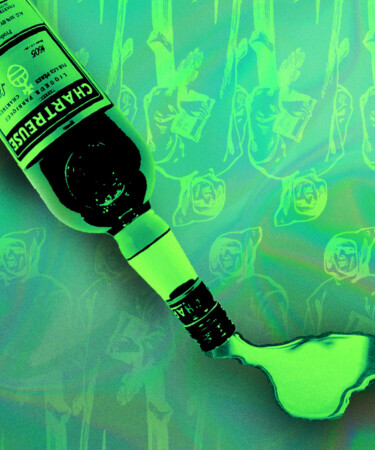After three years of the Covid era causing labor shortages, supply chain distribution hurdles, and inventory shortages, none of us are strangers to not being able to find our favorite products on shelves. So, in 2022 when drinkers started coming up short at their local bottle shops when looking to replenish their Chartreuse supplies, many might have assumed that the Covid-era shortages had claimed a new victim.
While the myriad pandemic-related distribution struggles have no doubt exacerbated the situation, this is actually not the cause. Rather, the Chartreuse “shortage” people may be noticing has religious origins and, unlike other modern-day shortages, this one won’t be going away any time soon.
Since the early 1700s, Chartreuse — both green and yellow — has been distilled by the Carthusian monks of the Grande Chartreuse monastery in France, based on a recipe dating back to 1605. The recipe, which contains over 100 botanicals, was described as “an elixir for long life,” and was altered slightly to make Chartreuse. Today it is only known in full by three monks.
Originally produced to be the struggling economy of the Grande Chartreuse monastery, the liqueur — not quite an “elixir for long life” — has grown to be a fan favorite of professional bartenders and novice mixologists alike. So much so that the monks quietly decided in 2021 to pull back their production of the beloved spirit and announced in January 2023 that Chartreuse would be produced and sold on an allocation-only basis in order for them to “protect their monastic life and devote their time to solitude and prayer.”
“The monks are not looking to grow the liqueur beyond what they need to sustain their order,” the letter from Voiron, where Chartreuse is distilled, shared by writer Jason Wilson via the Everyday Drinking Substack. “Making millions of cases does not make any sense in today’s environmental context and will have a negative impact on the planet in a very short term.”
Prior to the pandemic, Chartreuse had mainly been used in on-premise settings like swanky cocktail bars and restaurants whipping up classic cocktails that featured the ingredient. As such, sales were expected to plummet once these establishments were forced to shut their doors to protect public health. However, as we all know now, quarantine brought about a wave of at-home cocktail making, and sales of Chartreuse actually increased, driving the monks to pull back on production.
“[They] made the decision that we were growing too fast,” Tim Master, who works with importer Frederick Wildman and Sons to sell the spirit in the U.S., told InsideHook in October 2022. “Making Chartreuse was taking away from their main vocation, which is to live in prayer, solitude, and contemplation. To keep up with demand, they would have had to get more monks to help. They would have to use more resources and create more facilities.”
As production was pulled back in 2021, the effects are only just now being felt. “Green Chartreuse is MIA except at a certain liquor store that shall remain nameless. Even Total Wine is out,” one Redditor notes. “I’ve had conversations with managers at regional chains who told me it was backordered for six months or more,” another user shares. Some crafty mixologists have even created riffs on classic cocktails using Chartreuse — like the Last Word — replacing the ingredient with Aperol and calling it “The First Word.”
In other regions of the United States, the effects of the “shortage” have yet to be felt, with some Reddit users responding to comments with things like “No shortage in the Maryland suburbs of D.C.” So, while the full impact of the monks’ decision may not yet be fully felt, it’s safe to say that if you come across a bottle, you should probably bring it home with you.
